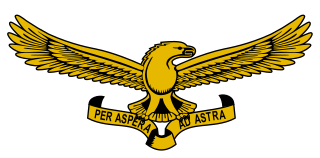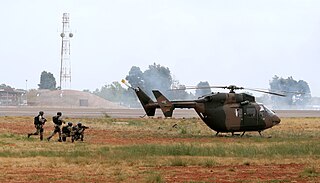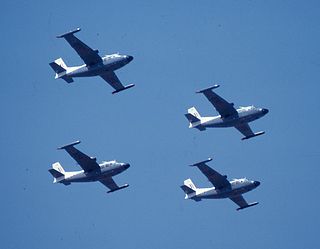
The British Commonwealth Air Training Plan (BCATP), or Empire Air Training Scheme (EATS) often referred to as simply "The Plan", was a massive, joint military aircrew training program created by the United Kingdom, Canada, Australia and New Zealand, during the Second World War. BCATP remains as one of the single largest aviation training programs in history and was responsible for training nearly half the pilots, navigators, bomb aimers, air gunners, wireless operators and flight engineers who served with the Royal Air Force (RAF), Royal Navy Fleet Air Arm (FAA), Royal Australian Air Force (RAAF), Royal Canadian Air Force (RCAF) and Royal New Zealand Air Force (RNZAF) during the war.

London International Airport is located 5 nautical miles northeast of the city of London, Ontario, Canada.

The South African Air Force (SAAF) is the air warfare branch of South African National Defence Force, with its headquarters in Pretoria. The South African Air Force was established on 1 February 1920. The Air Force has seen service in World War II and the Korean War. From 1966 the SAAF was involved in providing infantry support in a low intensity war in Angola, South-West Africa and Rhodesia. As the war progressed, the intensity of air operations increased until in the late 1980s, the SAAF were compelled to fly fighter missions against Angolan aircraft in order to maintain tactical air superiority. On conclusion of the Border War in 1990, aircraft numbers were severely reduced due to economic pressures as well as the cessation of hostilities with neighbouring states.

15 Squadron SAAF is a squadron of the South African Air Force. It is currently a transport/utility helicopter squadron.

22 Squadron is a squadron of the South African Air Force. It is currently a maritime helicopter squadron operating Lynx and Oryx helicopters for the South African Navy. Originally formed in 1942, the squadron is the only current maritime helicopter squadron of the SAAF. It has been involved with many rescues, some gaining international attention as well as arctic base support.

1 Squadron SAAF was an air force squadron of the South African Air Force and was formed at Air Force Station Swartkop in February 1920, equipped with De Havilland DH.9's part of the Imperial Gift donation to South Africa by Britain. On 31 August 1939 the squadron was re-designated as 1 Bomber/Fighter Squadron and this was then changed to 11 (Bomber) Squadron in December 1939. The squadron was resurrected in February 1940 by the renumbering of 6 Squadron, equipped with four Hurricane Mk 1's and six Furies.

Air Force Base Ysterplaat is an airbase of the South African Air Force. It is located in Cape Town suburb Ysterplaat, on the southwestern coast of South Africa. The name Ysterplaat is Afrikaans from the Dutch "Ijzerplaats" meaning "Iron Place" or "Place of Iron" in English.

Alexander Adolphus Dumphries Henshaw, was a British air racer in the 1930s and a test pilot for Vickers Armstrong during the Second World War.

Perth Airport is a general aviation airport located at New Scone, 3 nautical miles northeast of Perth, Scotland. The airport is used by private and business aircraft, and for pilot training. There are no commercial scheduled flights from the airport.

Chichester/Goodwood Airport, normally referred to as Goodwood Airfield or Goodwood Aerodrome is located 1.5 nautical miles north northeast of Chichester, West Sussex, England.

Sharpe Field is a closed private use airport located six nautical miles (11 km) northwest of the central business district of Tuskegee, a city in Macon County, Alabama, United States. This airport is privately owned by the Bradbury Family Partnership.

Gravesend Airport, located 2.5 miles (4.0 km) south-east of Gravesend town centre, Kent and 7.0 miles (11.3 km) west of Rochester. It was operated from 1932 until 1956. It was initially a civil airfield, and became a Royal Air Force station known as RAF Gravesend during the Second World War, when it was under the control of RAF Fighter Command during the Battle of Britain. It was the first RAF station to operate the North American Mustang III. The airport returned to civilian use at the conclusion of the Second World War, although it remained under the ownership of the Air Ministry until its closure in 1956. It is notable that a decision had to be made in 1954, by the Air Ministry, as to whether this civil airport should be retained and substantially enlarged, or the extensions east of Thong Lane be released for residential development. Kent County Council had made it clear that the land west of Thong Lane, was identified as a Civil Airport. Additionally, Kent County Council also informed the Air Ministry, that it would neither support nor oppose enlargement, acknowledging, however, that it would as a result of any such enlargement, the site becoming designated as a fully operational international airport.

Lingayen Airport is the airport serving the general area of Lingayen, the capital of the province of Pangasinan in the Philippines. It is one of two airports in the province: the other being Rosales Airport. It is classified as a community airport by the Civil Aviation Authority of the Philippines. The airport was built by the Americans in 1945.

27 Squadron was established as a World War II maritime patrol squadron of the South African Air Force. It was disbanded after the war and resurrected in the same role from 1951 to 1958. Its final period of service was from 1962 to 1990 when it was finally disbanded when its Piaggio Albatross aircraft were de-commissioned.

Air Commodore Arthur Edmond Clouston, was a British test pilot and senior Royal Air Force officer who took part in several air races and record-breaking flights in the 1930s.
The History of the South African Air Force spans the First World War, Rand Rebellion of 1922, the Second World War, the Korean War, the South African Border War, and varied peacekeeping operations since 1994. Its battle honours include German South West Africa 1914–15, German East Africa 1915–1918, East Africa: 1939–1941, Middle East: 1941–43, Madagascar 1942, Italy 1943–1945, the Balkans 1943–1945, and Korea 1950–1953.

42 Squadron SAAF is a disbanded squadron of the South African Air Force, active from 1945 to 2000. The squadron's main role was to spot enemy artillery. The unit was formed in 1945 as 42 AOP Flight, flying Austers under command of an officer of the SA Artillery and was the only army aviation unit flying for South African forces during World War II.

Almaza Air Force Base Airport is a regional airport in north-eastern Cairo, the capital of Egypt. It was established as a civilian aerodrome, but was partly taken over by the British military, designated RAF Heliopolis and later RAF Almaza. Today it is a military aerodrome of the Egyptian Air Force as well as regional civil airport.


















